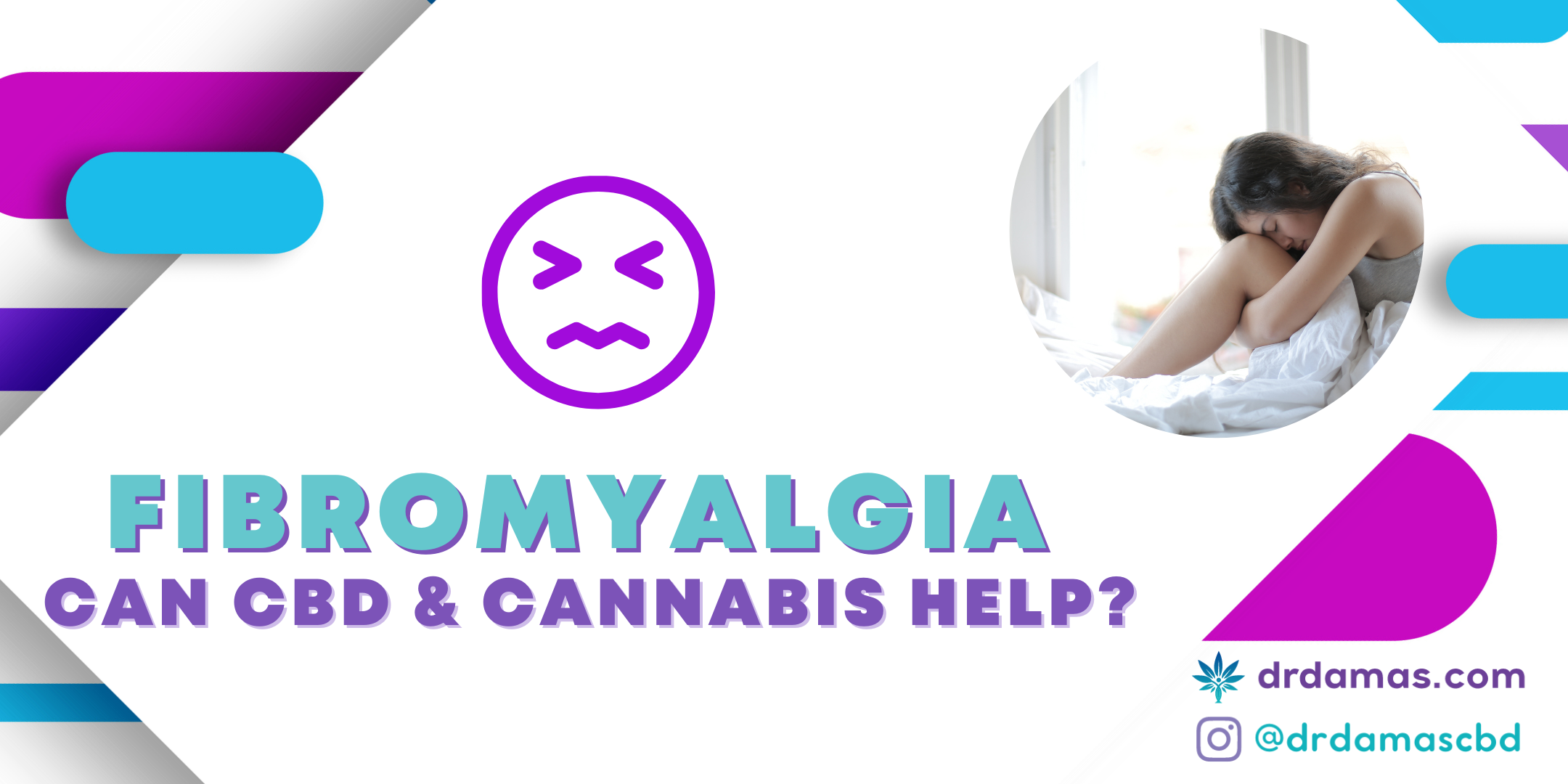Can Holistic treatments, CBD & Cannabis Help Manage Fibromyalgia?
What is Fibromyalgia?
The first time I heard the term fibromyalgia was listening to the radio decades ago and a commercial came on promoting treatments. At the time, I had no idea what it was- but I remember thinking to myself “that sounds horrible”. Imagine just being riddled with pain for no understandable reason and not being able to find anything to help treat it?
Later, when I started med school clinicals, I remember being told (unfortunately) by some of my preceptors that fibromyalgia was not a real thing. Sometimes they seemed to question the veracity of patients' complaints as if they were drug seekers or suffering from Munchausen's syndrome.
The truth is that fibromyalgia is a chronic disorder that causes widespread pain throughout the body, often accompanied by fatigue, sleep disturbances, memory issues, and mood changes. This condition primarily affects how the brain processes pain signals, leading to an amplified sense of pain, even from stimuli that wouldn’t normally be painful.
Studies suggest that fibromyalgia may stem from various factors, including genetic predisposition, infections, and physical or emotional trauma. However, the exact cause remains unclear, making it a challenge to diagnose and treat effectively.
Pearls:
Fibromyalgia is considered a neurological disorder because it affects how the brain processes pain signals.
New research suggests that small fiber neuropathy (damage to small nerve fibers) may be present in up to 50% of fibromyalgia patients.
Demographics: Who is Affected by Fibromyalgia?
Fibromyalgia affects an estimated 4 million adults in the United States, or about 2% of the population, according to the CDC. Women are far more likely to be diagnosed with fibromyalgia, making up nearly 80-90% of cases. The condition is also more commonly diagnosed in middle-aged individuals, although people of any age can develop it. Socioeconomic factors also play a role, with lower-income individuals reporting more severe symptoms, likely due to reduced access to healthcare and treatment.
Ethnic disparities exist in fibromyalgia diagnosis, with some studies showing that African Americans may experience more severe symptoms than their white counterparts. These demographic insights are essential for understanding both who is most at risk and how the condition presents in different populations.
Pearls:
Women are 9 times more likely than men to be diagnosed with fibromyalgia, often during their 30s to 50s.
Recent research suggests fibromyalgia may be linked to imbalances in neurotransmitters such as serotonin and dopamine.
Traditional Treatments for Fibromyalgia
The treatment for fibromyalgia often involves a multidisciplinary approach due to the complexity of its symptoms. Traditional treatments typically include medications such as pain relievers, antidepressants, and anti-seizure drugs. Common medications include:
Pain relievers: Over-the-counter medications like ibuprofen and naproxen can help with mild symptoms but often are insufficient for managing chronic pain.
Antidepressants: Medications like duloxetine (Cymbalta) and milnacipran (Savella) are FDA-approved to treat fibromyalgia and can help manage pain and fatigue.
Anti-seizure medications: Drugs like pregabalin (Lyrica) are often prescribed to reduce pain in fibromyalgia patients.
While these treatments can provide symptom relief, many patients experience side effects such as drowsiness, dizziness, and gastrointestinal issues. Moreover, the effectiveness of traditional treatments varies significantly from person to person, requiring constant adjustments.
Pearls:
While pregabalin is one of the most commonly prescribed drugs for fibromyalgia, it can cause side effects like weight gain and blurred vision.
In 2007, pregabalin (Lyrica) became the first drug approved by the FDA for fibromyalgia treatment.
Holistic Treatments for Fibromyalgia
In recent years, many people with fibromyalgia have turned to holistic or complementary therapies to manage their symptoms. These approaches are often used in combination with traditional treatments and can include:
Acupuncture: Some studies suggest acupuncture may help reduce pain and improve the quality of life in fibromyalgia patients.
Massage therapy: Massage can promote relaxation and reduce muscle stiffness, a common symptom of fibromyalgia.
Yoga and Tai Chi: Mind-body practices such as yoga and tai chi have been shown to improve mood, reduce pain, and enhance overall well-being in people with fibromyalgia.
Dietary changes: Some patients find that eliminating processed foods or adopting anti-inflammatory diets (rich in omega-3s and antioxidants) can lessen their symptoms.
However, not all holistic treatments are supported by robust scientific evidence, and results can vary. While many patients find these approaches helpful, they are often best used in conjunction with traditional treatments.
Pearls:
Studies show that low-intensity aerobic exercises, like walking or swimming, can help reduce pain and improve function in people with fibromyalgia.
Some fibromyalgia patients report symptom improvements with a gluten-free or low-FODMAP diet, though more research is needed.
Cannabis and CBD for Fibromyalgia: Routes of Administration and Benefits
Cannabis and cannabidiol (CBD) have become increasingly popular for managing fibromyalgia symptoms, especially in cases where traditional treatments have failed. Cannabis contains compounds known as cannabinoids, which interact with the body’s endocannabinoid system, a network involved in pain regulation.
Smoking or Vaping: Smoking or vaporizing cannabis provides rapid relief, as the cannabinoids enter the bloodstream through the lungs. However, smoking may irritate the lungs and is not recommended for individuals with respiratory issues.
Edibles: Edibles, such as cannabis-infused gummies or chocolates, offer longer-lasting effects, though they take longer to kick in—often up to two hours. They can be an excellent option for sustained symptom management throughout the day.
Topicals: Cannabis or CBD creams can be applied directly to painful areas for localized relief without producing psychoactive effects. This route is helpful for patients with isolated pain points, such as sore muscles or joints.
CBD Oil or Tinctures: These can be taken sublingually (under the tongue) for fast absorption into the bloodstream. This method allows for precise dosage control, making it a preferred option for those managing fluctuating symptoms.
Research is ongoing, but early studies suggest that cannabis and CBD can alleviate pain, improve sleep quality, and reduce anxiety in fibromyalgia patients. However, more robust clinical trials are needed to confirm these benefits fully.
Pearls:
A 2021 study found that CBD can reduce chronic pain in conditions like fibromyalgia, with minimal side effects.
Edible forms of cannabis can provide longer-lasting relief, making them ideal for nighttime use to improve sleep quality.
Wrapping it All Up
I’ve learned a lot about fibromyalgia since I first heard those commercials many years ago. I’ve learned not only from studying it but mostly and more importantly from my patients. I’m very grateful for my fibromyalgia patients because the sharing of their experiences teaches me and inspires me to find new and better ways to help.
Fibromyalgia is a challenging condition that requires a multifaceted approach to management. From medications and alternative therapies to emerging options like cannabis and CBD, treatment is highly individualized. The key is finding a combination that works for you and staying informed about new research and treatment methods. If you’re interested in adding CBD to your treatment plan here are some tips: only buy from trusted sources, make sure you consult with a health care provider and of course feel free to contact us with any questions (we’re alway happy to hear from y'all 😊).
Pearls:
Fibromyalgia affects about 2% of adults in the U.S., with women being disproportionately affected.
Studies are increasingly highlighting the potential benefits of cannabis, not just for pain but also for improving sleep and reducing anxiety in fibromyalgia patients.















